AstraZeneca/Oxford vaccine trial (and its further discontents!)
Tagged:COVID
/
PharmaAndBiotech
/
SomebodyAskedMe
/
Statistics
Somebody asked me about the AstraZeneca press release on their new Phase 3 vaccine trial. AstraZeneca has done it again… just not in a good way.
What’s the sitch?
Perhaps you may recall that this blog has expressed some impatience with AstraZeneca’s previous clinical trial [1]. The situation seems to have been:
- They outsourced the manufacture of doses for this trial to a contract manufacturing organization (CMO), which in itself is perfectly reasonable.
- But they did not assay the CMO’s product to make sure they were getting what they thought they were getting. So when one CMO screwed up and made half doses, they didn’t catch it.
- They did not randomize the lots from CMOs across the trial sites. So the trial sites and the viral variants circulating there became hopelessly convolved with low vs high dose.
- Stunningly, some sites had an upper age cutoff, while others did not. In another statistical accident, the low/high doses became hopelessly convovled with younger vs older subjects.
This is the sort of thing that makes a grizzled old statistician cry.
Their scientists, we absolutely must note, did the right thing: they went to the regulatory bodies, explained the situation, and got a protocol amendment to try a 2-dose Phase 3 trial. That’s unusual, since you’re supposed to know the dose already from Phase 2, but it’s the best move to salvage as much as could be salvaged.
But then, when they read out last November, their management admitted none of this. They averaged across trial sites with different doses, different ages, and different viral variants – thereby averaging over apples, oranges, and sledgehammers. None of that came out until people dug and asked inconvenient questions. Their CEO, Pascal Soriot, had the gall to claim it wasn’t a mistake because they amended the protocol [2]:
Soriot disputed the idea that the half-dose regimen was an error, saying that after researchers realized the dosing discrepancy they formally changed the trial protocol with the blessing of regulators.
“I won’t tell you we expected the efficacy to be higher,” said Soriot. But “people call it a mistake – it’s not a mistake.”
Yeah. Taking a pratfall and then saying “I meant to do that” always increases your credibility.
You know what actually increases your credibility? Saying something like: “Hey, we screwed up in a few places here. We’ve taken these steps to make sure it doesn’t happen again. In the meantime, here’s the most honest case we can make with the slighlty compromised data. We think it looks pretty good, and would appreciate peer review.” That has the virtue of being true, positioning yourself as being honest, and placing reliance on data rather than personalities.
This is, we admit, a hard lesson to learn.
So what have they done this time?
General media reports
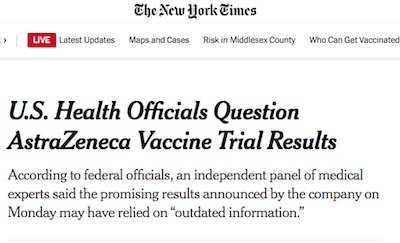
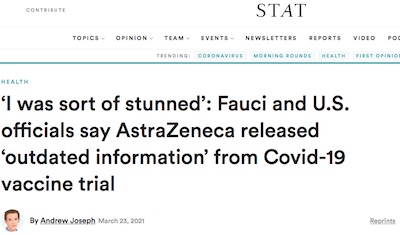 For our first pass over the issue, let’s look at what the (more or less) general media
have to say. The report from the New York Times by Robbins,
et al. [3] sets the state in general. Then, as seems now
to be the custom, we went to the usually more scientifically- and mathematically-literate
STAT News for an article by A Joseph [4]:
For our first pass over the issue, let’s look at what the (more or less) general media
have to say. The report from the New York Times by Robbins,
et al. [3] sets the state in general. Then, as seems now
to be the custom, we went to the usually more scientifically- and mathematically-literate
STAT News for an article by A Joseph [4]:
- The press release stands accused of using ‘outdated information’, apparently cherry-picking time points to get data “most favorable for the study as opposed to the most recent and most complete.” (NYT quoting from the DSMB (Data Safety Monitoring Board) letter, the text of which I haven’t been able to find.) AZ says (below) that they were just reporting the interim data, not the complete data to be submitted to the FDA.
- AZ claimed 79% efficacy overall (which is very good), and 80% efficacy above age 65 (i.e., statistically indistinguishable from younger patients, also very good). However, the DSMB statisticians said their analysis gave a confidence interval of 69% – 74%, below the quoted figure by AZ. That’s a serious problem. It could have arisen if AZ reported the interim dataset, while the DSMB used the full dataset. But in that case, AZ is being misleading by reporting the higher number on the smaller dataset.
- You never report data that is a surprise to the FDA, especially if they have a bigger dataset than you and somehow you report better numbers on the smaller dataset!
- If you’ve never seen a knife-flash when scientists duel, here’s an example. The NYT
quotes from the DSMB letter to AZ:
“Decisions like this are what erode public trust in the scientific process.”
- Apparently at the root of the problem is the exact procedure for identifying trial subjects who contract COVID-19: symptoms, PCR test, antigen test, etc. The DSMB twice urged AZ to go the more rigorous route, and AZ apparently ignored this and did what they wanted, instead. If you want to know how to get into deep trouble with the FDA, this is exactly how it’s done.
- So AZ’s report was (a) on partial data only, and (b) used a more favorable way of calling the COVID-19 cases, both of which combine to boost the apparent efficacy. They also didn’t inform the DSMB of their intent to make an announcement, so it came as a surprise to the DSMB which had different results. Not a brilliant manuver, as it’s both misleading and sure to get caught (as it was, within hours of release).
Some expert statements
Eric Topol, clinical trial expert at the Scripps Institute:
… highly irregular … I’ve never seen anything like this. It’s so, so troubling.
Tony Fauci, head of NIAID in the NIH:
I was sort of stunned. The data safety and monitoring board were concerned that the data that went into the press release by AZ was not the most accurate and up to date data. That is what the DSMB communicated to AZ in a rather harsh note. Having seen that letter we could not just let it go unanswered.
…
We just felt we could not remain silent. Because if we did remain silent, we could be understandably accused of covering something up. And we definitely didn’t want to be in that position.
…
In my mind, it’s an unforced error by the company.
An “unforced error” for a late-stage drug candidate about to go before approval boards is very harsh criticism. Also accurate, as far as I can see.
Tony Fauci on the potential to undermine public confidence in science and in particular in the safeguards in place for medical approvals:
If you look at it, the data really are quite good, but when they put it into the press release, it wasn’t completely accurate. We have to keep essentially trying as hard as we can to get people to understand there are safeguards in place.
…
Obviously that’s [public confidence in vaccines] a concern whenever something like this happens, that it could erode public trust, yes.
Primary sources
Ok, that’s more or less the media situation. But what do the primary sources say, from the principals involved in the matter?
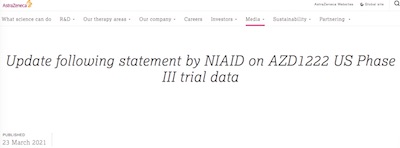
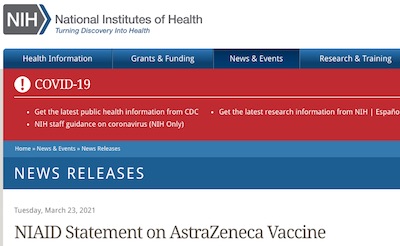
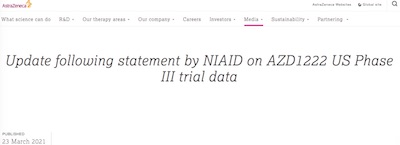 We looked at the AZ press release announcing the 79% efficacy
result [5], the NIH statement about the letter they sent to
AZ in response [6], and the AZ response to
that [7]. However, we couldn’t find the text of the actual
letter from the DSMB to AZ; that’s apparently not public, though the NYT above did quote
a few blistering sentences from it.
We looked at the AZ press release announcing the 79% efficacy
result [5], the NIH statement about the letter they sent to
AZ in response [6], and the AZ response to
that [7]. However, we couldn’t find the text of the actual
letter from the DSMB to AZ; that’s apparently not public, though the NYT above did quote
a few blistering sentences from it.
- The relevant clinical trial is NCT045167.
- AZ’s claims: 79% efficacy overall, 80% efficacy in age 65+, no particular differences across ethnicities, and 100% efficacy vs severe disease and hospitalization.
- They do mention, in fairness to AZ, that this based on an interim readout, not the full and final dataset provided to the regulatory authorities.
- There were no serious adverse events, including the worrisome thromboembolisms.
- They’re about to submit to the FDA and to a peer-reviewed journal.
- The doses were 4 weeks apart, though previous data said there was even more immune response if they’re separated by 12 weeks. That would support a “first-doses-first” strategy, since there’s a lot of slack in the time between doses.
- The cold chain is quite vanilla, like ordinary refrigerators. This is very encouraging, for delivery to rural areas in the developed world and to the entire developing world.
Overall, this is a very hopeful and good result. One can totally understand AZ’s eagerness to say this as loudly and publicly as possible.
Now, we don’t know exactly what the DSMB letter to AZ said. But the NIH/NIAID folks felt strongly enough about it to comment:
- They were concerned with the use of ‘outdated data’, giving an ‘incomplete view of the efficacy’.
- NIH/NIAID said they ‘urge the company to work with the DSMB to review the efficacy data and ensure the most accurate, up-to-date efficacy data be made public as quickly as possible’.
How serious is that? The statement itself, issued in the middle of the night, is unprecedented. I’d translate it as roughly: “Hey, the DSMB wants to burn you guys at the stake. We thought we’d urge you to work it out, while they’re gathering firewood.” Given that they’re about to go before the VRBPAC at the FDA, this is serious indeed.
AZ’s response:
- The press release was based on an analysis pre-specified in the clinical trial protocol, on the interim data readout.
- They thought it would be consistent with the final analysis of the final readout; the DSMB thought otherwise.
We will immediately engage with the independent data safety monitoring board (DSMB) to share our primary analysis with the most up to date efficacy data. We intend to issue results of the primary analysis within 48 hours.
What does all that mean?
Basically, it looks like a fine vaccine. But the AZ management has been a bit of a clown show with mismanaged communication, lack of transparency, attempts to spin everything to make themselves look better, and so on.
The sad part: they don’t need to do this! The vaccine is good enough to speak for itself.
Believe it or not, there is a certain charm to simply telling the truth, and even to telling the truth simply. — Molly Ivins
Addendum 2021-Mar-25
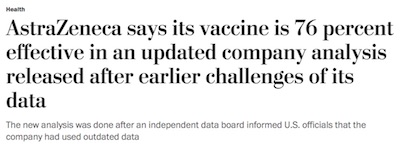 Well, that didn’t take long.
Well, that didn’t take long.
Yesterday the WaPo reported [8] that AstraZeneca revised their public estimate of efficacy downward, from their initial claim of 79% to 76%. This is still a bit of a problem, since as we saw above, the FDA is still claiming an efficacy range of 69% — 74%. But it’s less of a problem, which I suppose is about as much as we can expect from AZ these days.
Let’s see what happens in front of the VRBPAC committee at the FDA, if they apply for authorization in the US. But, as the WaPo says:
The new data may not resolve challenges that the vaccine and the company face in the United States, because repeated missteps have sown confusion and distrust that may result in slower and closer scrutiny of the data.
Notes & References
1: Weekend Editor, “AstraZeneca/Oxford vaccine interim readout (and its discontents)”, Some Weekend Reading blog, 2020-Nov-07.↩
2: S Ring & J Paton, “Astra Eyes Extra Global Vaccine Trial as Questions Mount”, Bloomberg, 2020-Nov-26. ↩
3: R Robbins, S LaFraniere, & N Weiland, “U.S. Health Officials Question AstraZeneca Vaccine Trial Results”, New York Times, 2021-Mar-23. ↩
4: A Joseph, “‘I was sort of stunned’: Fauci and U.S. officials say AstraZeneca released ‘outdated information’ from Covid-19 vaccine trial”, STAT News, 2021-Mar-23. ↩
5: AstraZeneca, “AZD1222 US Phase III trial met primary efficacy endpoint in preventing COVID-19 at interim analysis”, AstraZeneca Press Releases, 2021-Mar-22. ↩
6: National Institutes of Health, “NIAID Statement on AstraZeneca Vaccine”, NIH News Releases, 2021-Mar-23. ↩
7: AstraZeneca, “Update following statement by NIAID on AZD1222 US Phase III trial data”, AstraZeneca Press Releases, 2021-Mar-23.↩
8: C Johnson, “AstraZeneca says its vaccine is 76 percent effective in an updated company analysis released after earlier challenges of its data”, Washington Post, 2021-Mar-24. ↩

Gestae Commentaria
Comments for this post are closed pending repair of the comment system, but the Email/Twitter/Mastodon icons at page-top always work.